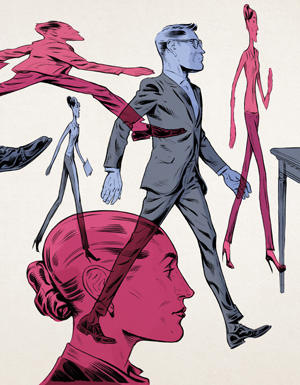Lawyer storytellers break free from the clock to deliver persuasive arguments

Illustration by Lars Leetaru
Listen: Billy Pilgrim has come unstuck in time.
Billy has gone to sleep a senile widower and awakened on his wedding day. He has walked through a door in 1955 and come out another one in 1941. He has gone back through that door to find himself in 1963. He has seen his birth and death many times, he says, and pays random visits to all the events in between.
—Kurt Vonnegut Jr., Slaughterhouse-Five
One of the joys of getting older is that now, when rediscovering a book, it is almost as if I am listening to the story for the first time. Sometimes the story completely absorbs my attention and interest. This happened when I listened to Slaughterhouse-Five during a summer drive to Maine.
The plot: Billy Pilgrim, a traumatized WWII vet, returns to the ‘burbs in Ilium, New York. Pilgrim remains a prisoner forever inside himself, trapped in the horror of his wartime past. (Pilgrim, like Vonnegut—who appears as both a character in and narrator of his novel—was a prisoner of war in Dresden as it was firebombed and destroyed by the Allies.)
There is the delicious plot twist that transforms the story into Vonnegut’s custom blend of dark comedy and science fiction: Pilgrim is abducted by aliens, transported to the planet Tralfamadore and bred with the lovely earthling movie star Montana Wildhack. On Tralfamadore, moments exist independently from one another, and stories do not unfold in a linear or orderly way. As a result, Pilgrim finds himself thrown about in time; he time-travels from one place to another, from present to past to future and back again in a disordered progression of disconnected moments that make no sense to Pilgrim but, miraculously, make for a marvelous story.
For Vonnegut, a former creative writing teacher at the Iowa Writers’ Workshop, Slaughterhouse-Five provides a playful critique of how all storytellers manipulate time, shaping and ordering events into compelling and coherent stories. This is true for the stories that lawyers tell. When we construct our stories, whether ordering evidence in a trial or drafting the statement of the case in an appellate brief, it is as if we too have been temporarily abducted by aliens and transported to the planet Tralfamadore. “Real” time (the ticking of the clock) is no longer controlling and we are compelled, like Pilgrim, to travel in story-time.
Driving back from Maine, I pulled off the interstate and scribbled down this takeaway: As Billy Pilgrim experiences after his alien abduction, all lawyer-storytellers become unstuck in time. We may not suffer the same fate as Pilgrim, who is committed to a mental hospital after he publishes his revelations about his time travels. But we will certainly lose credibility if our use of time for persuasion becomes too obvious, seems false, or is simply too far-fetched for our audience to believe in or follow.
CONSIDERING CHRONOLOGY
How do we order events and then move about in time when telling law stories? The starting point is chronology, suggesting a linear sequence of events that replicates the order of how events purportedly happened in real time. Novelist and writing teacher David Lodge observes: “The simplest way to tell a story, equally favored by tribal bards and parents at bedtime, is to begin at the beginning and go on until you reach the end or your audience falls asleep.” Narrative theorist Gerald Prince explains: “The arrangement of situations and events in the order of their occurrence—‘Harry washed; then he slept’—observes a chronological order, whereas ‘Harry slept after he worked’ does not.”
In law, we typically attempt initially to tell our stories chronologically. Why? Clarity, credibility and causality. The first two reasons are obvious; the third, perhaps the most important, is less frequently identified.
Clarity and credibility. Juries and judges appreciate and need a linear chronological timeline upon which they can order and affix the events of a story. Sean Grennan, a playwright, observed in the ABA Journal after serving on a jury how a printed, chronological timeline ordering events in a complex torts case locked in the jury’s narrative (See “Unsolicited Advice,” April.) As Grennan puts it, the timeline provided “clean storytelling in a crushproof box.” There is a presumption that chronological order embodies how events transpire in the real world, arousing the least suspicion in the audience (especially an audience of skeptical jurors) because the telling does not seem manipulated by the narrator.
Causality. But we employ chronology for another important reason—a chronological sequence presupposes crucial causal relationships between the events depicted in a story. What do I mean? All storytellers rely on the powerful psychological presumption that sequence and causality are intertwined, that earlier events in a story cause what happens next. This effect is exaggerated in legal storytelling where, on the one hand, juries are admonished not to go beyond the evidence presented at trial in shaping their narratives and, on the other, assigned to determine causal responsibility for narrative outcomes in verdicts and judgments.
ON ‘ANACHRONY’
Unfortunately, there isn’t, umm, “time” to identify all the ways that lawyer-storytellers intentionally and unintentionally depart from chronology whenever we tell law stories. Here is one technique narrative theorist Prince identifies that enables storytellers to travel in time:
“Anachrony: A discordance between the order in which events (are said to) occur and the order in which they are recounted: a beginning in media res followed by a return to earlier events constitutes a typical anachrony. In relation to the ‘present’ moment, the moment when a chronological recounting of a sequence of events is interrupted to make room for them, anachronies can go back into the past (retrospection, analepsis, flashback) or forward into the future (anticipation, prolepsis, flash-forward).”
Do lawyer-storytellers employ anachrony? Of course we do. For example, I am reading a brief in a criminal appeal that begins with the story of the trial beneath a header (The Trial and Issues on Appeal). The brief then returns in time via flashback to the story of the horrific crime itself that led to the trial and the court’s evidentiary ruling at issue on appeal.
Story-time is reshaped, emphasizing the procedure while downplaying the crime itself. The same happens in the courtroom, often without the audience’s awareness, when attorneys arrange presentation of evidence and witnesses, organizing the trial story strategically, reordering time to achieve persuasive purposes.
In the state criminal trial of Los Angeles Police Department officers for the Rodney King beating, defense attorneys successfully slowed down time into what narrative theorists label a “stretch.” They did this by replaying a slow-motion, frame-by-frame version of the famous video of King’s beating that defused the cumulative power of the imagery.
BEGINNINGS AND ENDINGS
There are numerous other ways that legal storytellers time-travel. For example, we slow down story-time when we present complete scenes (showing rather than telling) and speed up time by employing summaries (telling rather than showing).
Likewise, we predetermine the length (discourse time) of our stories when we select a beginning or choose an ending point to give meaning and closure to the events depicted in the tale.
Contrast this with Tralfamadorian stories, where, Vonnegut wrote, “there is no beginning, no middle, no end, no suspense, no moral, no causes, no effects. What [Tralfamadorians] love in [stories] are the depths of many marvelous moments seen all at one at a time.”
In Slaughterhouse-Five, time just runs out. And Vonnegut simply employs the mocking irony of an exotic bird’s refrain as an exit line: ”[This story] begins like this: Listen: Billy Pilgrim has become unstuck in time. It ends like this: Poo-tee-weet.”
This article originally appeared in the November 2016 issue of the ABA Journal with this headline: “Manipulating Time: Lawyer storytellers break free from the clock to deliver persuasive arguments.” Philip N. Meyer, a professor at Vermont Law School, is the author of Storytelling for Lawyers.



